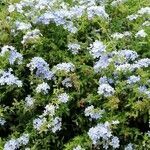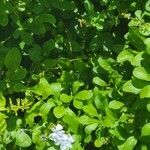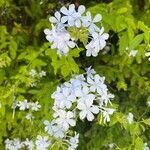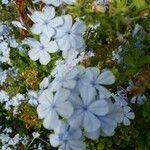Shrub or scrambler up to about 2 m or more tall, striate, freely branched and suckering. Leaves oblong or oblong-spathulate, narrowed to each end, up to about 5 cm long and 2-2.5 cm broad, obtuse or occasionally subacute, glabrous, sometimes lepidote on under surface, petiolate; petiole short often slightly winged stem-clasping and eared at the base. Inflorescence in terminal spikes 3-10 cm long, rhachis puberulous; bracteoles ovate-or lanceolate-oblong, acute. 5-7 mm long. Calyx 1-1.3 cm long, tubular, united by membrane and with short free lobes, puberulous and also bearing gland-tipped setae on the upper 1/2 or 2/3. Corolla pale blue; tube about 3 cm; limb about 2.5 cm in diam.; lobes obovate, obtuse. Stamens reaching the mouth of the tube; anthers blue. Capsule pentagonal, turbinate.
Plants evergreen shrubs. Stems erect, trailing, or climbing, diffusely branched, to 3+ m, glabrous or pubescent on youngest shoots. Leaves usually sessile, sometimes short-petiolate; blade elliptic, oblanceolate, or spatulate, (1-)2.5-9 × 0.5-2.5 cm, base usually long-attenuate, sometimes auriculate, apex acute or obtuse, mucronate. Inflorescences 2.5-3(-5) cm, rachises short-pilose (hairs ca. 0.1 mm), eglandular; floral bracts lanceolate, 3-9 × 1-2 mm. Flowers 3-stylous; calyx 10-13 mm, tube usually short-pilose and with stalked, capitate, glandlike protuberances ca. 1 mm along distal 1/ 3/ 4 of ribs; corolla pale blue, 37-53 mm, tube 28-40 mm (more than 2 times length of calyx), lobes 10-16 × 6-15 mm; stamens included or exserted. Capsules 8 mm. Seeds brown, 7 mm. 2n = 14 + 0-1B.
Shrub, 0.3-1.4 m high; suckering. Leaves alternate, oblong or oblong-spathulate, narrowed at each end, apex obtuse to subacute, lower surface sometimes lepidote; petioles amplexicaul, auriculate at base. Inflorescences terminal spikes, up to 100 mm long; bracteoles up to 7 mm long. Calyx 5-lobed, tubular, up to 13 mm long, puberulous with gland-tipped setae in upper 2/3. Corolla pale blue; funnel-shaped, with 5 obovate, spreading lobes. Stamens reaching mouth of tube; anthers blue. Ovary ± conical; style terminal, filiform, hairy, 5-branched, stigmatic along inner surfaces. Flowering time July-May. Fruit a pentagonal, turbinate capsule.
Erect shrub or halfshrub,⅓-1½ m. Leaves oblong to obovate, 1½-5 by ¾-2 cm, auricles mostly large. Upper axils with a bundle of leaves. Racemes mostly combined to leafy corymbs; rachis 1-6 cm long, densely puberulous. Calyx green, 10-14 mm long, lower ⅓-⅔ puberulous but without glands. Ovary pear-shaped, style base glabrous.
Perennial herb or small shrub to 2 m..Leaves shortly petiolate, obovate or elliptic.. Peduncle shortly and densely white-hairy.. Calyx 1–1.2 cm. long, with sparse short white hairs and fairly abundant stalked glands on the upper part.. Corolla light blue, the tube 25–30 mm. long, the lobes broadly obovate, 10–14 mm. long.
Shrub or scrambler, up to 2 m or more high. Leaves with blade oblong or oblong-spathulate, up to 50 x 20-25 mm, sometimes lepidote on lower surface. Flowers: axis of spike generally puberulous; calyx setae glandular-capitate, absent from basal third; corolla 40-50 mm long, pale blue; Jun.-Mar.
A shrub. It can be somewhat climbing. It can grow 2-4 m tall. The leaf stalk is winged at the base and clasps the stem. The leaves are narrowly oval and their are scales underneath. The leaves are greyish-green underneath. The flowers have a pale blue tube and wide lobes.
Shrub or scrambler, up to 2 m or more high. Leaves oblong or oblong-spathulate, sometimes lepidote on undersurface. Axis of spike generally puberulous. Calyx setae glandular-capitate, absent from basal third. Corolla 40-50 mm long. Flowers pale blue.
Leaves with short petioles, obovate or elliptic, up to 5 cm. long, 2–2·5 cm. wide, obtuse, mucronate, glabrous, often lepidote on lower surface.
Shrub or scrambler to 20 m. Leaves oblong, 20-25 mm long. Flowers in terminal spikes, pale blue, calyx glandular-hairy above.
Calyx 10–13 mm. long, ribbed, bearing short white hairs, and fairly abundant stalked, mostly recurved, glands on upper half.
Corolla pale blue, tube up to 30 mm. long, lobes obovate, obtuse, 10–14 mm. long.
Bracts ovate or ovate–lanceolate, 5–7 mm. long.
Shrub, often semi–scandent, up to 2 m. high.
Peduncle with dense short white hairs.
Stems striate, woody.









